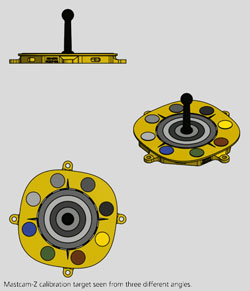Contributions of the Mars group
The Niels Bohr Institute Mars group contributes expertise and in some cases deep space flight hardware to three of the seven science instruments on the 2020 rover: the oxygen production experiment MOXIE, the advanced camera Mastcam-Z, and SuperCam - a combined camera, laser and LIBS*, IR, and RAMAN-spectrometer.
We will deliver a complete radiometric calibration target for Mastcam-Z, as well as essential parts for the calibration target for the SuperCam instrument. The parts for Mastcam-Z and SuperCam are currently under development. On the MOXIE experiment we work on characterization of Martian airborne dust, which may potentially cause problems for the equipment producing the oxygen.

Mastcam-Z radiometric calibration target seen from three different angles. Top: Side view. Bottom: Seen from above. The size of the target is 10x10x7 cm. Image credit: NBI-University of Copenhagen.
Mastcam-Z
Mastcam-Z will be a further development of the scientific stereo cameras flown on NASA's Curiosity mission - for the 2020 mission these cameras will be equipped with zoom-lenses.
In 2013 Kjartan Kinch and Morten Bo Madsen from the Mars group were invited by the instrument Principal Investigator, Professor Jim Bell, Arizona State University, to participate in the Science Team behind the proposal and development of these new cameras.
The Mars group has designed the radiometric calibration target for the Mastcam-Z instrument. The target provides surfaces of different colours and grey tones, whose reflectance properties are well-known from laboratory tests and therefore will be used to calibrate the images taken by the instrument.
Specially designed magnets - called sweep magnets - are mounted underneath the coloured and grey toned circular colour chips along the edge of the calibration target. These are designed so as to keep these areas as clean as possible from falling airborne dust. Previous results from the Mars Exploration Rovers and the Phoenix Mars Lander mission have shown that such magnets can keep the surface directly above them almost completely clean of the Martian airbourne dust. This effect is caused by the presence of magnetic minerals in almost all of the dust particles.
MOXIE
The MOXIE experiment will test - in the natural Martian environment - the production of oxygen directly from the Martian atmosphere (MOXIE is short for Mars OXygen In situ resource utilization Experiment). Such production capabilities are important for future human exploration of Mars, since the oxygen can be used for breathing, as well as for a necessary oxidant for the fuel used during the return journey to Earth.
The Principal Investigator of the experiment is Mike Hecht, assistant director of research management at the MIT Haystack Observatory, Massachusetts Institute of Technology. In 2013 he invited Morten Bo Madsen from the NBI Mars group on the MOXIE Science Team to participate in the proposal and development of this experiment and to work on characterization of Martian airborne dust.
SuperCam
SuperCam is a combined colour camera (remote microscopic imager), laser and LIBS*-, IR-, and RAMAN-spectrometer, which will provide information on the mineralogy and the atomic and molecular composition of targets down to sub mm-size in the Martian rocks and soil. From distances of several meters it can acquire a number of different types of spectra as well as high-resolution images.
Morten Bo Madsen from the Mars group is part of the SuperCam Science Team, where he participates in the design process of essential parts of SuperCam's calibration target, which is needed to calibrate its measurements against targets with known properties.
*LIBS means Laser Induced Breakdown Spectroscopy


